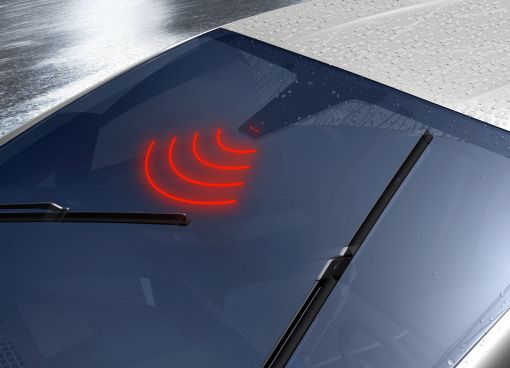New photodiode generation: revised package concept makes it easier for the customer
Osram Opto Semiconductors presents the world’s first SMT package for large-area photodiode chips which complies with the strict demands of the automotive industry and is even approved up to an operating temperature of 125°C. The new SFH 2200 A01 and SFH 2200 FA A01 photodiodes meet the requirements for
AEC-Q101-C qualification and are ideally suited for use in rain sensors. Once again, Osram Opto Semiconductors has followed the trend for miniaturization with these products and has made the new photodiodes much smaller than their predecessors.
Developers at Osram Opto Semiconductors have succeeded in significantly improving the moisture sensitivity level (MSL). This index is used to determine when the amount of moisture in the component is high enough for damage to be caused during soldering. After the components have been unpacked and exposed to air for the first time, customers now have more time to solder the SFH 2200 A01 and SFH 2200 FA A01 on the board. This applies to storage of the component under defined conditions at a temperature of ≤ 30 °C and 60 percent humidity after the dry packaging has been opened. That corresponds to an MSL of 2, giving customers the assurance that they can solder the products in the component up to a year later without the possibility of damage. This translates into extraordinary flexibility for the work processes. Comparable products have an MSL of 4, which means, for example, that after only 72 hours there is no guarantee that the component can be soldered without causing damage. In addition, the new broadband diodes are surface mountable. They are soldered using the reflow method, making it very easy to check the solder at all the contacts.
“One of the ways we achieved MSL level 2 for the SFH 2200 A01 and the SFH 2200 FA A01 was by using encapsulation material containing silicone. As a result, moisture and gases can escape more quickly during soldering”, explains Ralph Schregle, Marketing Manager at Osram Opto Semiconductors. The flexibility of the silicone in combination with the stability of the plastic package of the component ensures that the photodiodes are particularly robust.
Further miniaturization of the component shows that flexibility and user friendliness are the focal points of the new SFH 2200 A01 and SFH 2200 FA A01 from Osram Opto Semiconductors. The footprint of their compact packages is 4.0 mm x 5.1 mm x 0.85 mm – much smaller than the 4.0 mm x 6.5 mm x 1.15 mm of their predecessors, the BPW34S and BPW34FAS.
The main application for the new photodiodes will be rain sensors mounted behind car windshields. When a raindrop falls on the windshield the diodes detect a change in the incidence of light. This change is then translated by the system into control of the windshield wipers and the rate at which they operate.
SFH 2200 A01 and SFH 2200 FA A01 are almost identical silicon photodiodes. The only difference is that SFH 2200 FA A01 has a daylight filter whereas SFH 2200 A01 does not.


ABOUT OSRAM
OSRAM, based in Munich, is a leading global high-tech company with a history dating back more than 110 years. Primarily focused on semiconductor-based technologies, our products are used in highly diverse applications ranging from virtual reality to autonomous driving and from smart phones to smart and connected lighting solutions in buildings and cities. OSRAM uses the endless possibilities of light to improve the quality of life for individuals and communities. OSRAM’s innovations enable people all over the world not only to see better, but also to communicate, travel, work and live better. OSRAM has approximately 26,400 employees worldwide as of end of fiscal 2017 (September 30) and generated revenue of more than €4.1 billion. The company is listed on the stock exchanges in Frankfurt and Munich (ISIN: DE000LED4000; WKN: LED400; trading symbol: OSR). Additional information can be found at www.osram.com.